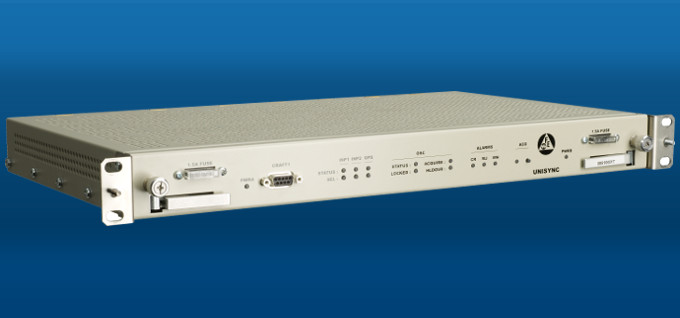UNISYNCa

This particular UNISYNC model has particularities appreciated by the US market where it is intended to be used.
The UNISYNC (also called UNISYNCa) is intended to provide time based networks with a reliable, durable and accurate Timing Signal Generator (TSG). The UNISYNC is also intended to operate as a mini SSU (Synchronization Supply Unit).
The UNISYNC is a microprocessor controlled TSG with powerful software management features enabling configuration flexibility from a simple array of standardized hardware modules. It is designed to operate as a mini Synchronization Supply Unit (SSU/BITS) for common clock distribution to a limited number of Network Elements (NE’s) requiring external timing for synchronization.
It has been designed to comply with all Telcordia and ITU-T G.811 and G.812 international telecom recommendations. It incorporates a high performance GPS timing receiver and can be equipped with additional reference input modules to accept two timing reference signals of various formats and sources. It provides rear panel output connectors for 1-5-10 MHz, 1PPS, and DS1 output timing references. Moreover, the number of telecom timing outputs can be expanded by the addition of an internal plug and play output expansion module. The output expansion module provides 10 additional outputs for DS-1 and/or CC references. The UNISYNC can also be used for computer time synchronization, thanks to its NTP / SNTP server stratum level 1.
The UNISYNC contains a GPS reference receiver to provide Primary Reference Clock (PRC) capability. If desired, external reference inputs can still be used within the selection hierarchy or they may be monitored for performance characteristics.
The UNISYNC can be configured to accept external timing references of known or unknown Stratum levels (Sync Status Messaging) via a physical connection on the input Wire-wrap pin header panel located at the rear panel of the UNISYNC. The
UNISYNC continuously monitors all inputs (external input and GPS signal) for frequency accuracy and stability. If a reference fails to meet industry standard performance criteria, it is disqualified as the frequency reference for the shelf local
oscillator (LO). If the reference is disqualified, the system switches to the next available reference or goes into bridged or holdover mode.
- Quartz or Rubidium oscillator
- Integrated or externalized GPS receiver
- From 0 to 2 inputs, configurable E1, 2MHz, DS1 (EF or ESF), CC, 1, 5, 10 MHz
- From 2 to 12 outputs, configurable DS1 or CC
- 2 auxiliary outputs settable 1, 5, 10MHz
- 1 PPS output
- 1 TOD with PPS output
- NTP/SNTP Server Stratum Level 1 capability
- SSM, LOS, AIS, OOF, and BPV support
- Total Software (local and remote) Management
- Optional IRIG A/B
- GPS Solution
- Standalone Mini-SSU for remote or small offices
- NTP/SNTP Server
CONSTRUCTION…



